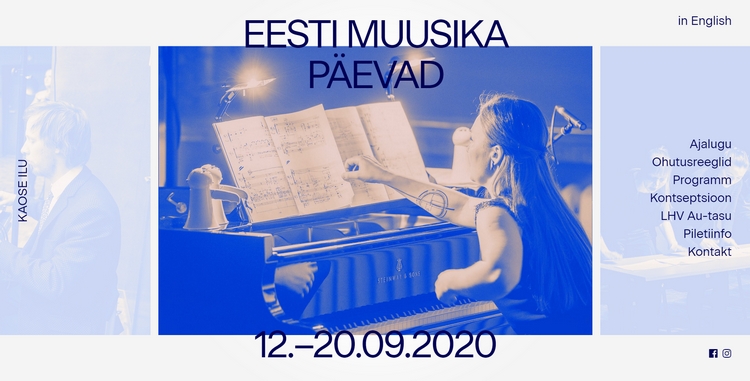 The last couple of years have been unusual for the Estonian Music Days. In 2019 the festival was bloated beyond all recognition and sense due to its assimilation into the World Music Days, making for a horribly hectic and exhausting experience. In 2020, for reasons pandemical, it was the opposite, postponed by six months and reduced to a skeletal representation of its former self, with just a single event each day. Every year the festival has a simple, pithy theme permeating its concerts, and this year’s was originally ‘Beauty’; however, in light of the changes made due to the pandemic this was altered to ‘Beauty of Chaos’. Nowhere was this more evident than in the arrangement of the concerts: originally intended as a countdown – with the opening concert titled ‘FIVE, FOUR, THREE, TWO, ONE’ – followed by a countup; ‘ZERO’, ‘ONE’, ‘TWO’, etc. closing with a climactic concert, alluding to the concept of beauty, titled ‘THE BEHOLDER’S GAZE’. In the end, due to subsequent rearrangements the beautifully chaotic order of concerts was ‘THREE’, ‘FIVE’, ‘FOUR’, ‘ZERO’, ‘TWO’ and ‘SEVEN’. The ordering hardly matters, of course, but the lack of larger-scale events, meaning that the festival lacked any orchestral or choral performances – which, every year, are among the most outstanding – was a very serious loss and the main reason why EMD 2020 felt so different from normal. Notwithstanding these pressures, though, the country’s longest-running music festival (established in 1979) managed to capture something of its usual glory, providing further insights into the characteristics and nature of Estonian contemporary music.
The last couple of years have been unusual for the Estonian Music Days. In 2019 the festival was bloated beyond all recognition and sense due to its assimilation into the World Music Days, making for a horribly hectic and exhausting experience. In 2020, for reasons pandemical, it was the opposite, postponed by six months and reduced to a skeletal representation of its former self, with just a single event each day. Every year the festival has a simple, pithy theme permeating its concerts, and this year’s was originally ‘Beauty’; however, in light of the changes made due to the pandemic this was altered to ‘Beauty of Chaos’. Nowhere was this more evident than in the arrangement of the concerts: originally intended as a countdown – with the opening concert titled ‘FIVE, FOUR, THREE, TWO, ONE’ – followed by a countup; ‘ZERO’, ‘ONE’, ‘TWO’, etc. closing with a climactic concert, alluding to the concept of beauty, titled ‘THE BEHOLDER’S GAZE’. In the end, due to subsequent rearrangements the beautifully chaotic order of concerts was ‘THREE’, ‘FIVE’, ‘FOUR’, ‘ZERO’, ‘TWO’ and ‘SEVEN’. The ordering hardly matters, of course, but the lack of larger-scale events, meaning that the festival lacked any orchestral or choral performances – which, every year, are among the most outstanding – was a very serious loss and the main reason why EMD 2020 felt so different from normal. Notwithstanding these pressures, though, the country’s longest-running music festival (established in 1979) managed to capture something of its usual glory, providing further insights into the characteristics and nature of Estonian contemporary music.
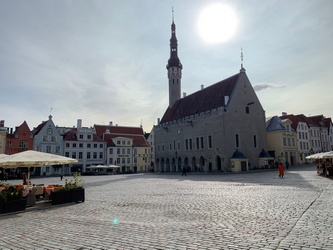 As an anecdotal aside, it’s perhaps worth stating, due to the difficult times we’re still living through, that even just a few days before i was supposed to set off it seemed inevitable that my trip would need to be cancelled. The UK was (and, at time of writing, continues to be) on Estonia’s list of countries requiring a 14-day isolation period on arrival, which would have made travelling there pointless. However, recently they have introduced an extremely well-organised Covid-19 testing facility at the airport (as well as the ports and a host of other places around the country) that provides a test result within 24 hours. Following a negative result, while still avoiding unnecessary contact with others, one is allowed to resume normal work activities. This meant that, while i was forced to miss one concert on the day i arrived (while waiting for my result), it was possible for me to attend the last five days of the festival in the comfortable knowledge that, thus far, i’ve successfully avoided the plague. It’s also worth mentioning that, in stark contrast to the UK, i felt incredibly safe and relaxed in Estonia. Though the infection numbers there (like seemingly everywhere at the moment) are on the rise, they’re nonetheless comparatively low and the populace is evidently able to go about their daily lives without having to give it much thought. It was a real oasis of calm away from the UK’s less-than-perfect approach to managing the crisis. That being said, people’s general reluctance to travel was even more in evidence than when i went to Switzerland last month. The airports were more-or-less deserted (with many of the shops and restaurants closed), the planes i took were less than half full (and all of them arrived at least 20 minutes early – perhaps due to reduced air traffic), and the streets of Tallinn were eerily empty. Considering it was mid-September and the weather was generally sunny and quite warm (at least by Estonian standards), to see the place so barren was a very unsettling experience. It made me realise anew how much the atmosphere of a place or an event is enhanced and characterised by the people who are there with us. It was honestly hard to say whether the pros – quiet flights; peaceful travel; having the city to yourself – outweighed the cons. Strange days.
As an anecdotal aside, it’s perhaps worth stating, due to the difficult times we’re still living through, that even just a few days before i was supposed to set off it seemed inevitable that my trip would need to be cancelled. The UK was (and, at time of writing, continues to be) on Estonia’s list of countries requiring a 14-day isolation period on arrival, which would have made travelling there pointless. However, recently they have introduced an extremely well-organised Covid-19 testing facility at the airport (as well as the ports and a host of other places around the country) that provides a test result within 24 hours. Following a negative result, while still avoiding unnecessary contact with others, one is allowed to resume normal work activities. This meant that, while i was forced to miss one concert on the day i arrived (while waiting for my result), it was possible for me to attend the last five days of the festival in the comfortable knowledge that, thus far, i’ve successfully avoided the plague. It’s also worth mentioning that, in stark contrast to the UK, i felt incredibly safe and relaxed in Estonia. Though the infection numbers there (like seemingly everywhere at the moment) are on the rise, they’re nonetheless comparatively low and the populace is evidently able to go about their daily lives without having to give it much thought. It was a real oasis of calm away from the UK’s less-than-perfect approach to managing the crisis. That being said, people’s general reluctance to travel was even more in evidence than when i went to Switzerland last month. The airports were more-or-less deserted (with many of the shops and restaurants closed), the planes i took were less than half full (and all of them arrived at least 20 minutes early – perhaps due to reduced air traffic), and the streets of Tallinn were eerily empty. Considering it was mid-September and the weather was generally sunny and quite warm (at least by Estonian standards), to see the place so barren was a very unsettling experience. It made me realise anew how much the atmosphere of a place or an event is enhanced and characterised by the people who are there with us. It was honestly hard to say whether the pros – quiet flights; peaceful travel; having the city to yourself – outweighed the cons. Strange days.
 As is usually the case, a great deal of the music at this year’s Estonian Music Days involved electronics. At the concert on Friday night, held at one of the Estonian Public Broadcasting studios, electronics were the entire focus, with each of the seven featured works presented in conjunction with choreographed light displays designed by Priidu Adlas. These displays were little more than a fairly simple response to each piece, but considering how often concerts of electronic music are, from a visual perspective, incredibly drab and uninteresting affairs, they heightened the mood and added a little extra drama. In a few instances (especially Rebeca Vilpuu‘s Crash and Ekke Västrik‘s interminable Hidden Noise) the lights were considerably more interesting than the sounds, but during the best pieces they became irrelevant. In the case of Otto Iivari‘s Static, this was largely due to the fact that the piece struck a curious relationship with a small antique TV set at the front of the stage. This was nominally the world première of the piece, though it had also snuck into a late evening concert the night before as part of a series of student concerts titled ‘MiniCOMMUTE #2’ that coincided with the festival. It was great to have had the opportunity to experience the piece twice, as the nature of the relationship between what we see and what we hear is deceptive. Throughout, the TV screen displays a consistent stream of static that makes one wonder whether its a mixture of randomness and several clear bands corresponds exactly, partially or not at all to the accompanying electronic sounds. Or, indeed, the other way round. The ambiguity was beguiling enough, but the music itself was deeply effective, encompassing raw juddering tones, ticking electronica, soft quasi-animal calls and occasional lurches into growling cinematic intensity. It was easily one of the most memorable pieces of this year’s festival.
As is usually the case, a great deal of the music at this year’s Estonian Music Days involved electronics. At the concert on Friday night, held at one of the Estonian Public Broadcasting studios, electronics were the entire focus, with each of the seven featured works presented in conjunction with choreographed light displays designed by Priidu Adlas. These displays were little more than a fairly simple response to each piece, but considering how often concerts of electronic music are, from a visual perspective, incredibly drab and uninteresting affairs, they heightened the mood and added a little extra drama. In a few instances (especially Rebeca Vilpuu‘s Crash and Ekke Västrik‘s interminable Hidden Noise) the lights were considerably more interesting than the sounds, but during the best pieces they became irrelevant. In the case of Otto Iivari‘s Static, this was largely due to the fact that the piece struck a curious relationship with a small antique TV set at the front of the stage. This was nominally the world première of the piece, though it had also snuck into a late evening concert the night before as part of a series of student concerts titled ‘MiniCOMMUTE #2’ that coincided with the festival. It was great to have had the opportunity to experience the piece twice, as the nature of the relationship between what we see and what we hear is deceptive. Throughout, the TV screen displays a consistent stream of static that makes one wonder whether its a mixture of randomness and several clear bands corresponds exactly, partially or not at all to the accompanying electronic sounds. Or, indeed, the other way round. The ambiguity was beguiling enough, but the music itself was deeply effective, encompassing raw juddering tones, ticking electronica, soft quasi-animal calls and occasional lurches into growling cinematic intensity. It was easily one of the most memorable pieces of this year’s festival.
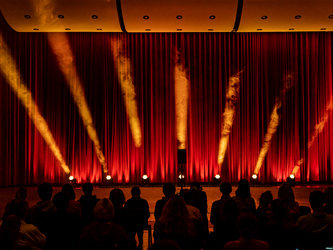 Also somewhat cinematic in nature was 462 by Johanna Kivimägi (another world première). Though gestural, the music conveyed a strong sense of evolutionary continuity, along the way evoking (but never imitating) horror filmic tropes in its stop-start stings and deep glowering. The ending of the work seemed weak and unconvincing, but this was only because the rest had been so highly atmospheric and involving. Daniel Blinkhorn‘s Anthozoa was more sculptural, created from tiny pinpricks of sound (so short as to be timbrally anonymous) and small granular clusters. Its language was sparse, minimal, lowercase, nicely utilising multi-channel to create a sense of movement and expanse. Organic and fluid, it was also sufficiently passive (in the best sense) that it gave the impression of being a field recording from an exotic, alien forest. Juuso Sebastian Salonen‘s 2018 The Birth of Kannel brought together fragments of speech and folk-like material to construct an abstract narrative about the titular instrument. Despite it being impossible to understand what was being talked about (and this was almost as true for the Estonian audience as it was for me, since the speech was Finnish), it was impossible not to get caught up in its increasingly joyous revelling in the material, leading to a kaleidoscopic climax of kannel cut-up clatter with an accordion acting as a more stable, pitch-focused foil. Genuinely marvellous.
Also somewhat cinematic in nature was 462 by Johanna Kivimägi (another world première). Though gestural, the music conveyed a strong sense of evolutionary continuity, along the way evoking (but never imitating) horror filmic tropes in its stop-start stings and deep glowering. The ending of the work seemed weak and unconvincing, but this was only because the rest had been so highly atmospheric and involving. Daniel Blinkhorn‘s Anthozoa was more sculptural, created from tiny pinpricks of sound (so short as to be timbrally anonymous) and small granular clusters. Its language was sparse, minimal, lowercase, nicely utilising multi-channel to create a sense of movement and expanse. Organic and fluid, it was also sufficiently passive (in the best sense) that it gave the impression of being a field recording from an exotic, alien forest. Juuso Sebastian Salonen‘s 2018 The Birth of Kannel brought together fragments of speech and folk-like material to construct an abstract narrative about the titular instrument. Despite it being impossible to understand what was being talked about (and this was almost as true for the Estonian audience as it was for me, since the speech was Finnish), it was impossible not to get caught up in its increasingly joyous revelling in the material, leading to a kaleidoscopic climax of kannel cut-up clatter with an accordion acting as a more stable, pitch-focused foil. Genuinely marvellous.
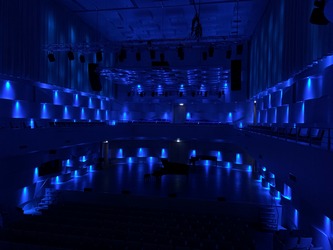 A much more powerful use of light came at the MiniCOMMUTE concert later the same evening. Titled ‘Murdumised hapral pinnal’ (fractures on a fragile surface) and taking place in the Estonian Academy of Music and Theatre’s stunning new Suur Saal (great hall), the concert featured pianist Johan-Eerik Kõlar performing works by Ravel and Debussy alternating with short electronic pieces, each receiving their first performance. While the latter were fairly generic in a floaty, ambient kind of way (though Hendrik Kaljujärv‘s Vaheosa II, a kind of dark dronal meditation, was particularly striking), the piano music was absolutely riveting.
A much more powerful use of light came at the MiniCOMMUTE concert later the same evening. Titled ‘Murdumised hapral pinnal’ (fractures on a fragile surface) and taking place in the Estonian Academy of Music and Theatre’s stunning new Suur Saal (great hall), the concert featured pianist Johan-Eerik Kõlar performing works by Ravel and Debussy alternating with short electronic pieces, each receiving their first performance. While the latter were fairly generic in a floaty, ambient kind of way (though Hendrik Kaljujärv‘s Vaheosa II, a kind of dark dronal meditation, was particularly striking), the piano music was absolutely riveting.
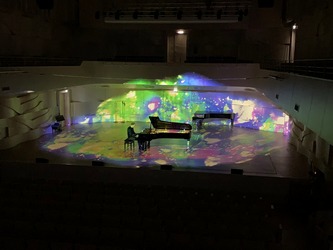 While Kõlar played, video compositions – by Andrea Albanese, Svetlana Mar, Kristjan Kannukene, Áki Frostason and Stefano Mattozzi – were projected, not onto a screen but onto the stage itself, in such a way as to transform it into a habitat that was fantastical, and ever-shifting. The piano became enveloped by halos of light, floated through space, drifted on the surface of water, plunged into vivid splashy foam, was surrounded by hovering lanterns, placed on windy tufts of grass. Not only was it stunningly beautiful, but it matched the music perfectly, conjuring up an allusive, impressionistic environment. It’s important to stress that the key to the success of this performance was Kõlar’s playing, which managed to be both fastidious and deeply emotive. In particular his rendition of ‘Ondine’ and ‘La Gibet’ from Gaspard de la Nuit was revelatory, bringing stunning clarity to the cascades and intricacies of Ravel’s music. Kõlar definitely needs to get into a studio as soon as possible and make a recording of this piece.
While Kõlar played, video compositions – by Andrea Albanese, Svetlana Mar, Kristjan Kannukene, Áki Frostason and Stefano Mattozzi – were projected, not onto a screen but onto the stage itself, in such a way as to transform it into a habitat that was fantastical, and ever-shifting. The piano became enveloped by halos of light, floated through space, drifted on the surface of water, plunged into vivid splashy foam, was surrounded by hovering lanterns, placed on windy tufts of grass. Not only was it stunningly beautiful, but it matched the music perfectly, conjuring up an allusive, impressionistic environment. It’s important to stress that the key to the success of this performance was Kõlar’s playing, which managed to be both fastidious and deeply emotive. In particular his rendition of ‘Ondine’ and ‘La Gibet’ from Gaspard de la Nuit was revelatory, bringing stunning clarity to the cascades and intricacies of Ravel’s music. Kõlar definitely needs to get into a studio as soon as possible and make a recording of this piece.
